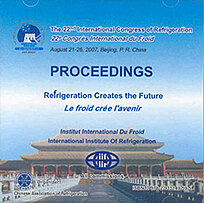
Résumé
The working principles and the basic features of a domestic air conditioning water heater system are introduced in this paper. The air conditioning water heater system can be operated in four modes: cooling with heating water, heating water only, cooling and heating. Comparatively, the system can provide much better energy performance and higher equipment utilization throughout a year, cause less thermal pollution than the heat-pump water heater and the domestic air conditioner. A prototype with four modes was assembled and its operation performance was tested with the ambient temperature from -7 to 43°C, especially when frosting. The results indicate that the new system can save energy through multi-duties, and it can work stably under the four work modes with high efficiency. Compared with other system models, the new system also includes air-conditioning unit and water heater unit, but with fewer components and better reliability. Based on a common air conditioner, this system can offer a practicable solution coupling domestic air conditioner and water heater parts. It will change the markets of both air conditioner and water heater equipment.
Documents disponibles
Format PDF
Pages : ICR07-E2-473
Disponible
Prix public
20 €
Prix membre*
Gratuit
* meilleur tarif applicable selon le type d'adhésion (voir le détail des avantages des adhésions individuelles et collectives)
Détails
- Titre original : Performance of an air-conditioning water heater system with four modes.
- Identifiant de la fiche : 2008-0355
- Langues : Anglais
- Source : ICR 2007. Refrigeration Creates the Future. Proceedings of the 22nd IIR International Congress of Refrigeration.
- Date d'édition : 21/08/2007
Liens
Voir d'autres communications du même compte rendu (839)
Voir le compte rendu de la conférence
Indexation
-
Reproducibility assessment of an emulator-type ...
- Auteurs : DONDINI D., GIANNETTI N., MIZUNO A., MIYAOKA Y., SAITO K.
- Date : 03/2024
- Langues : Anglais
- Source : International Journal of Refrigeration - Revue Internationale du Froid - vol. 159
- Formats : PDF
Voir la fiche
-
Recherches sur une pompe à chaleur au CO2 trans...
- Auteurs : XU H. T., et al.
- Date : 2001
- Langues : Chinois
- Source : Journal of Refrigeration - n. 3
- Formats : PDF
Voir la fiche
-
Dossier : pompes à chaleur.
- Auteurs : GRUMEL N.
- Date : 08/2001
- Langues : Français
- Source : CLIM Prat. - n. 41
Voir la fiche
-
Legionnaire's disease and water heating.
- Auteurs : WOLFEREN H. van
- Date : 10/10/2001
- Langues : Anglais
- Source : Hands-on experience with heat pumps in buildings. Workshop report [CD-ROM].
Voir la fiche
-
Experimental research on the application of R-4...
- Auteurs : ZHOU B., LI H., ZHANG C., et al.
- Date : 21/08/2007
- Langues : Anglais
- Source : ICR 2007. Refrigeration Creates the Future. Proceedings of the 22nd IIR International Congress of Refrigeration.
- Formats : PDF
Voir la fiche
